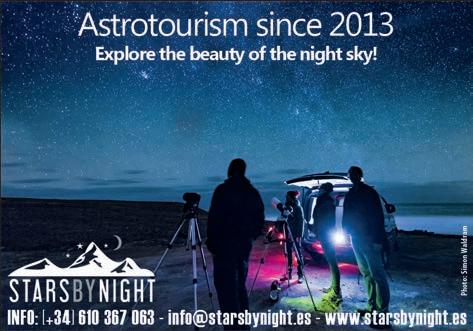
4 minute read
El cielo de noche de julio / ASTRONOMIE
calientes del verano, es el momento ideal para salir y observar el cielo de noche!
La Luna llena, la Súper Luna ocurre el día 3 de julio. Cuando se encuentra a su punto más cerca, la Luna está a 361934 kilómetros de la Tierra. Parece más grande y brillante en el cielo de noche y es un fabulosos espectáculo observar su salida. Obviamente, su brillo implica que la Vía Láctea no se podrá observar hasta el día 5 de julio y a medida que la Luna evoluciona hacia su fase de Tercer Cuarto y sale más tarde cada noche, la luz de la Vía Láctea vuelve a dominar el cielo de noche. La Tierra se encuentra a unos 26000 años luz del centro de nuestra galaxia, en el brazo de Orión. La Vía Láctea, llamada así por los griegos se refiere a los dos principales brazo en espiral de nuestra Galaxia, los brazos del Sagitario y de Perseo. El mito dice que la diosa Hera había rechazado el bebé Hércules de su pecho, y que gotas de su leche brillante se habían dispersado en el cielo. Pero cada cultura tiene su versión; los árabes y los indios americanos de los Grandes Lagos la veían como un río. Para los polinesios, la Vía Láctea es un tiburón que come nubes. Para algunos de los primeros hindúes de India, era el camino de su dios Aryaman hacia su trono divino. Para los galeses célticos, era el camino que su malicioso estafador y guerrero Gwydion había dejado persiguiendo a su esposa que huía de él. Los Maorí de Nueva Zelanda la ven como el canoa de Tami-reriti. Cada cultura tiene su propio mito en conexión con lo que veían en el cielo, pero la interpretación de los griegos y romanos ha dado el nombre que utilizamos, la Vía Láctea.
Advertisement
Stars by Night - Fuerteventura
El mes de julio es verdaderamente el mejor momento para observar el cielo de noche de Fuerteventura. Cuando la Luna está ausente, se puede observar la magnífica Vía Láctea durante toda la noche, saliendo en el cielo del Este y poniéndose en el cielo de Oeste. La famosa lluvia de meteoros de las Perseidas empieza el día de la

July night sky
Stars by Night - Fuerteventura

The month of July is a truly magical time to be observing the night sky of Fuerteventura. When the Moon is not present, the glorious Milky Way can be seen all night, rising in the Eastern Sky and setting in the west. The infamous Perseids Meteor Shower starts on the same day as the New Moon, running till the end of August. Mars and the ‘Evening Star’ Venus are still visible in the Western Sky and the gas giants Saturn and Jupiter are rising in the East. And we start the month with this year first Supermoon! The cycles of Nature displayed in a spectacular light show. With the warm summer nights it is time to get outside and experience the night sky!
The full moon, Supermoon rises on the 3rd July. At its nearest point, the Moon will be 361,934 km from Earth.
Nueva Luna, y continua hasta el final de agosto. Marte y la “Estrella de la Noche”, Venus, se pueden ver todavía en el Oeste y los gigantes de gas, Saturno y Júpiter salen en el Este. ¡Y empezamos el mes con la primera Súper Luna del año! Los ciclos de la naturaleza están expuestos en un fabuloso espectáculo de luces. ¡Con las noches
El mejor momento para observar las estrellas fugaces será desde el día 17 hasta el final del mes, con la lluvia de meteoros Delta Acuáridas que alcanza su punto máximo los días 29 y 30 de julio. La Luna estará presente, pero con la lluvia de meteoros de Las Perseidas presente al mismo periodo, tendremos bastantes oportunidades de pedir un deseo a las estrellas.
¡Cielos despejados a todos!
It should appear bigger and brighter in the night sky and will be a Wonder to observe rising. Of course the glare of ‘her’ light means the Milky Way is not visible till the 5th day and as the Moon moves towards Third Quarter phase and rising later each night, the light of the Milky Way can once again dominate the night sky. Planet Earth is about 26,000 light-years from the center of our galaxy, located in the Orion-Cygnus Arm. The Milky Way, as named in ancient times by the Greeks, “Via Lacteal” is referring to the two primary spiral arms of our Galaxy, the Sagittarius and Perseus Arms. The myth goes that the goddess Hera pushed the baby Hercules away from her breast, and a stream of her glowing breast milk gushed across the sky. But not all cultures saw it this way! The Arabs and Native Americans of the Great Lakes saw it as a river. Polynesians called the Milky Way a cloud-eating shark. To some early Hindus of India, it was the path of their god Aryaman upward to his heavenly throne. The Celtic Welsh saw it as the path that their sly trickster and warrior Gwydion left as he pursued his fleeing wife. The Maori of New Zealand see it as the canoe of Tami-reriti. Each culture had their own myths connected to what they saw in the Sky, but it was the Greek/Roman interpretation that has given us the name of our home, the Milky Way.
The best time to observe shooting stars will be form the 17th up until the end of the month, with the Delta Aquarid meteor shower peaking on the 29th/30th July. The Moon is present in these weeks, but with the Perseids Meteor shower running as well, there is always a chance to wish upon a shooting star.
Clear skies to everyone!










